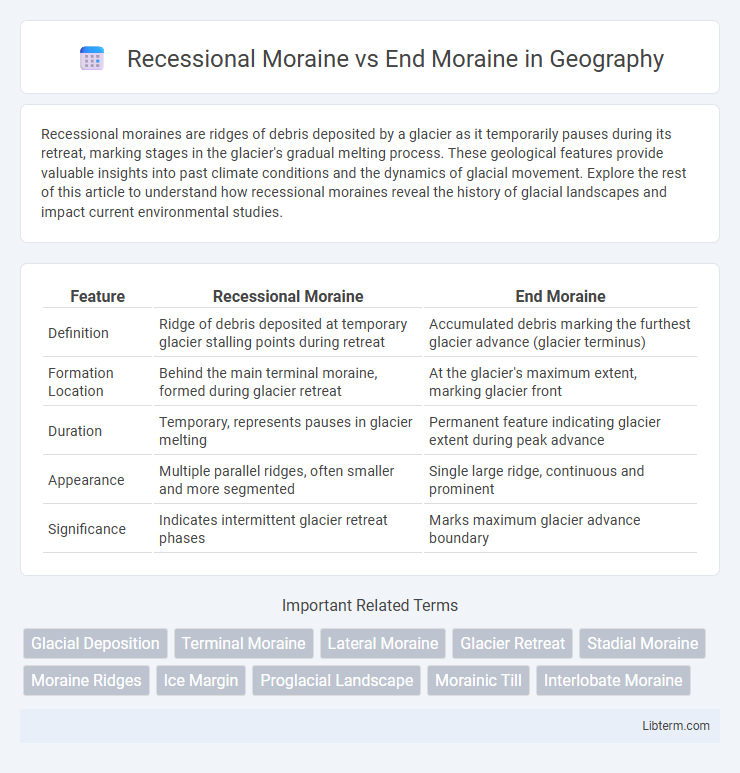Recessional moraines are ridges of debris deposited by a glacier as it temporarily pauses during its retreat, marking stages in the glacier's gradual melting process. These geological features provide valuable insights into past climate conditions and the dynamics of glacial movement. Explore the rest of this article to understand how recessional moraines reveal the history of glacial landscapes and impact current environmental studies.
Table of Comparison
| Feature | Recessional Moraine | End Moraine |
|---|---|---|
| Definition | Ridge of debris deposited at temporary glacier stalling points during retreat | Accumulated debris marking the furthest glacier advance (glacier terminus) |
| Formation Location | Behind the main terminal moraine, formed during glacier retreat | At the glacier's maximum extent, marking glacier front |
| Duration | Temporary, represents pauses in glacier melting | Permanent feature indicating glacier extent during peak advance |
| Appearance | Multiple parallel ridges, often smaller and more segmented | Single large ridge, continuous and prominent |
| Significance | Indicates intermittent glacier retreat phases | Marks maximum glacier advance boundary |
Introduction to Moraines
Recessional moraines form behind the terminal moraine as glaciers temporarily halt during their retreat, creating ridges that mark former glacier positions. End moraines represent the furthest advance of a glacier, accumulating debris at its snout during periods of ice movement stability. Both features provide critical insights into glacier dynamics and past climate conditions by mapping glacier extent and retreat patterns.
What Are Recessional Moraines?
Recessional moraines are ridges of debris deposited by a glacier as it pauses during its retreat, marking temporary halts in the glacier's backward movement. Unlike end moraines, which form at the glacier's maximum advance point, recessional moraines indicate stages within the overall melting process. These landforms provide valuable information about past glacial dynamics and climate conditions during the retreat phase.
What Are End Moraines?
End moraines are accumulations of debris deposited at the snout or terminus of a glacier, marking its furthest advance. These ridges consist of unsorted till and are key indicators of a glacier's maximum extent during a given period. Unlike recessional moraines that form during temporary pauses in a glacier's retreat, end moraines specifically denote the glacier's endpoint before it begins to recede.
Formation Processes of Recessional Moraines
Recessional moraines form during temporary pauses in a glacier's retreat, where sediment accumulates at the glacier's edge as it stabilizes momentarily. These moraines consist of till and debris deposited by melting ice, marking successive positions of the glacier's snout retreat. Unlike end moraines, which represent the glacier's maximum advance, recessional moraines indicate intermittent stages in the glacier's overall withdrawal.
Formation Processes of End Moraines
End moraines form at the terminus of a glacier where debris accumulates as the ice melts, marking the furthest advance of the glacier's front. These ridges consist of till--a mixture of unsorted rocks and sediments--deposited by sediment-laden meltwater or directly by the glacier's ice. Recessional moraines develop in a similar fashion but form during temporary halts in glacial retreat, creating a series of parallel ridges behind the main end moraine.
Key Differences: Recessional vs End Moraine
Recessional moraines form as temporary ridges marking pauses in a glacier's retreat, indicating stages of glacier stabilization. End moraines represent the furthest advance of a glacier, accumulating debris at its maximum extent and forming a prominent terminal ridge. The key difference lies in their formation timing and position: recessional moraines occur during glacier retreat, while end moraines denote the glacier's furthest reach.
Geological Significance of Each Moraine Type
Recessional moraines mark temporary halts during glacier retreat, revealing the glacier's stepwise melting patterns and past climatic fluctuations, crucial for reconstructing glacial dynamics and climate history. End moraines form at the maximum glacier advance, signifying the furthest edge of glacial extent, providing essential data on historical ice sheet boundaries and the glacier's maximum volume. Both moraine types are vital for understanding glacial processes, sediment deposition, and landscape evolution in paleoglaciology.
Examples of Recessional Moraines Worldwide
Recessional moraines form at pauses in glacier retreat and can be found in numerous locations worldwide, such as the Long Island moraine complex in the United States and the Athabasca Glacier in Canada. These features differ from end moraines, which mark the furthest advance of a glacier, like the terminal moraines of the Laurentide Ice Sheet across North America. The distinction highlights dynamic glacial processes reflected in landforms that record multiple stages of glacier retreat and stabilization.
Examples of End Moraines Around the Globe
End moraines form prominent ridges of debris deposited at the snout of glaciers, with famous examples including the Long Island moraine in the United States and the terminal moraines of the Alps in Europe. The Puget Sound region of Washington State features extensive end moraines that shaped its landscape during the last glacial period. These formations contrast with recessional moraines, which mark temporary halts in glacier retreat rather than its furthest advance.
Recessional Moraine vs End Moraine: Summary and Conclusion
Recessional moraines form during temporary halts in glacier retreat, creating ridges behind the primary glacier front, while end moraines mark the furthest advance or stable position of a glacier's terminus. The key difference lies in their formation timing, with end moraines representing the maximum glacier extent and recessional moraines indicating intermediate standstills during retreat. Understanding these distinctions is crucial for interpreting glacial history and past climate dynamics.
Recessional Moraine Infographic

 libterm.com
libterm.com